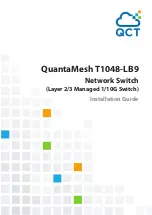
Chapter 3: Featuring Configuration
– Web UI
Featuring Configuration
– Web UI
NGSM48T2 User Manual | 132
MLD Snooping Configuration
This section provides MLD Snooping related configuration. The MLD is for IPv6
Multicast Snooping. The difference between the 2 IGMP and MLD is that the IGMP
is applied to IPv4 Multicast stream, the MLD is applied to IPv6 Multicast stream.
While configuring the MLD Snooping configuration, the only thing you need to
understand is the IPv6 packet format.
Basic Configuration
This basic configuration of the MLD, IPv6 Multicast Routing.
Most of the settings are global, whereas the Router Port configuration is related to
the currently selected stack unit, as reflected by the page header.
Snooping Enabled
Enable the Global MLD Snooping.
Unregistered IPMCv6 Flooding enabled
Enable unregistered IPMCv6 traffic flooding. Please note that disabling unregistered
IPMCv6 traffic flooding may lead to failure of Neighbor Discovery.
SSM Range
SSM (Source-Specific Multicast) Range allows the SSM-aware hosts and routers
run the SSM service model for the groups in the address range.
Leave Proxy Enabled
Enable MLD Leave Proxy. This feature can be used to avoid forwarding
unnecessary leave messages to the router side.
Proxy Enabled
Enable MLD Proxy. This feature can be used to avoid forwarding unnecessary join
and leave messages to the router side.
Router Port
Specify which ports act as router ports. A router port is a port on the Ethernet switch
that leads towards the Layer 3 multicast device or MLD querier. Normally, the router
port is the uplink port to the upper L3 Router or IGMP Querier. For example in below
figure, the green port of the 2 switches are Router port.
If an aggregation member port is selected as a router port, the whole aggregation
will act as a router port.
















































